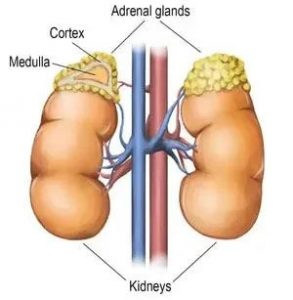Adrenal Disease
What is Adrenal Disease?
Adrenal gland disease or Adrenal gland disorders result in a patient’s hormone production being either
- too much of a hormone, or
- too little of a hormone
An example of an Adrenal Disease is when the Adrenal Gland cortisol hormone production is either
- too much cortisol (Cushing’s Syndrome), or
- not enough (Addison’s Disease) there is too little.
Some people are born unable to make enough cortisol.
What is the Anatomy of Adrenal Gland
The adrenal glands are small glands located on top of each kidney.
The Adrenal Glands produce hormones that you can’t live without, including:
- Adrenaline – for maintaining metabolic processes, such as managing blood sugar levels and regulating inflammation
- Aldosterone – for regulating the balance of salt and water
- Cortisol – for helps controlling the stress response and other functions.
- Sex Hormones – for helping initiate and control sexual maturation during childhood and puberty

Adrenal Gland Anatomy
Who are at Risk of Adrenal Disease?
People with certain hereditary conditions have a higher risk of developing an adrenal gland tumour.
What are the Causes of Adrenal Disease
These disorders can occur if there is a problem with the adrenal gland itself.
Causes of adrenal gland disorders include
- Functional adenomas (pheochromocytomas, Conn’s)
- Genetic mutations
- Tumours
- Infections
- Trauma
- A problem in another gland, such as the pituitary, which helps to regulate the adrenal gland
- Certain medicines
In addition, some medications can cause problems with how the adrenal glands function.
What are the Symptoms of Adrenal Disease?
Symptoms of Adrenal Disorders vary depending on the type of disease. Some common symptoms are:
- Hot flushes, sweating, palpitation
- High blood pressure
- Upper body obesity, round face and neck, and thinning arms and legs
- Skin problems, such as acne or reddish-blue streaks on the abdomen or underarm area
- Muscle and bone weakness
- Moodiness, irritability, or depression
- High blood sugars
- Slow growth rates in children
Types of Adrenal Disease?
There are many forms of Adrenal Disease. Some are:
- Cushing’s syndrome – the over-production of cortisol
- Primary hyperaldosteronism- high levels of the hormone aldosterone (controls blood pressure and body salt and potassium levels)
- Pheochromocytoma, by producing too much adrenaline (regulates the “fight-or-flight” response)
- Addison’s Disease – the under-production of cortisol (Adrenal insufficiency or crisis)
- Primary Adrenocortical Carcinoma
- Metastasis from other cancer origin (ie kidney, lungs, melanoma, breast)
- Pituitary Tumours
- Congenital Adrenal Hyperplasia (CAH)
Diagnostic Test for Adrenal Disease
Typically a pathology test is required for an effective diagnosis.
The type of suspected disorder may determine which pathology test is required. Some tests may require fasting or multiple tests at certain times of the day.
Samples collected could include:
- Blood
- Urine
- Saliva
Other diagnostic test includes:
- Adrenal CT or MRI
- MIBG scan (if suspicious of phaeochromocytoma)
Treatments for Adrenal Disease
Treatments for Adrenal Disease vary depend on the type of the disorder. Typically treatment is offered in a multidisciplinary setting in collaboration with endocrinologist.
There are two types of treatments available for Adrenal Disease, these are include:
- Medication
- Surgery
Medication for Adrenal Disease
Medications are available for some forms of Adrenal Disease. They can be used to either
- Stop the excess production of hormones, or
- Act as hormone replacement for low hormone production
Preparation for Adrenal Surgery Includes
- Specific blood and urine metabolic work,
- Additional tests or
- Consultation with other specialists may be required depending on your medical problems.
- Specific medications before, during and/or after your surgery.
Adrenal Surgery (Adrenalectomy)
An Adrenalectomy involves the removal of the adrenal gland. The surgery is performed under general anaesthesia and requires an overnight stay in the hospital (much longer if open approach is employed).
The surgical approach is determined by:
- tumour size and type (benign or malignant)
- patient characteristics (body size, shape, medical conditions, previous operations, etc)
- Contralateral adrenal gland
- The surgeon’s preferences
Types of Adrenalectomy
An Adrenalectomy can be performed either as an open and laparoscopic or Robotic procedure.
- Open Adrenalectomy uses a large incision (usually beneath the rib-cage). This approach is preferred for very large tumors and for tumors with a high risk of cancer.
- Laparoscopic or Robotic Adrenalectomy (minimally invasive) approach uses multiple small incisions and a camera to remove the adrenal gland.
